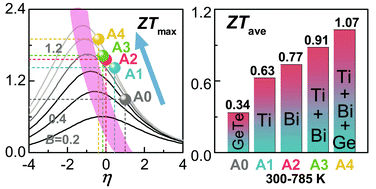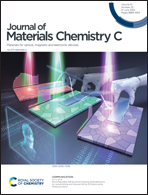Realizing high thermoelectric performance in GeTe by defect engineering on cation sites†
Abstract
GeTe-based materials have attracted a lot of attention due to their excellent thermoelectric performance. In this paper, the thermoelectric properties are enhanced via simultaneous Ti/Bi co-doping and Ge self-doping on cation sites of GeTe. Firstly, the equivalent replacement of Ge by Ti atoms leads to band convergence and the increase of the density of states. As a result, 1.5 mol% Ti doping in GeTe increases the effective mass from ∼1.13 m0 to ∼1.71 m0 and enhances the quality factor B from ∼0.69 to 1.33. Subsequently, Ti/Bi co-doping successfully reduces the carrier concentration (nH) from 8.21 × 1020 cm−3 (pristine GeTe) to 3.25 × 1020 cm−3. Based on the Ti/Bi co-doping, the effects of Ge-deficient and Ge-excess strategies are further investigated. The positive modulation of Ge deficiencies on lattice thermal conductivity (κL) is not enough to balance its negative influence on the electronic transport properties. Moreover, excessive Ge can further decrease nH, increase carrier mobility, and reduce κL due to the strong phonon scattering. Finally, a high maximum ZT of 1.89 at ∼735 K and an average ZT of 1.07 in the temperature range of 300–785 K are achieved in Ge0.945Ti0.015Bi0.06Te. The results demonstrate that defect engineering on cation sites is an effective way of optimizing the performance of GeTe-based thermoelectrics.



 Please wait while we load your content...
Please wait while we load your content...